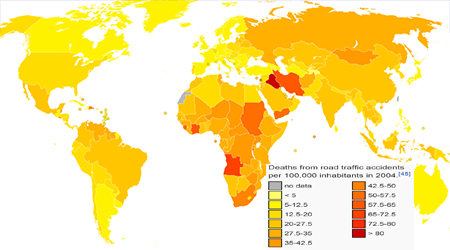InTrans / Apr 28, 2015
The more you know: How countries are combating road fatalities
Go! Magazine
 posted on April 28, 2015
posted on April 28, 2015
In the previous article “The more you know: Safety statistics around the world,” you learned that the world’s largest percentage of road fatalities (41 percent) happen in low-income counties (like Bangladesh) and often occur to “vulnerable” users, a group that includes bicyclists, pedestrians, and motorcyclists. In this article, we are exploring how road fatalities could be addressed through better enforcement of traffic laws.
Imagine yourself walking along a residential street near a school when suddenly a car speeds by at 45 miles per hour (mph)! Seems dangerous when you think about it, right? In many countries speed limits are either non-existent or not enforced.

According to the World Health Organization (WHO), only 15 percent of countries have traffic laws that are considered “comprehensive,” which means the other 85 percent of countries don’t fully regulate laws concerning speeding, drunk driving, helmet use, and seat belt and child restraints.
The WHO conducted a study looking at safety regulations in almost every country in the world (174 of 194 countries). Some of the countries included in the WHO study that have the highest road fatalities include South Africa, Ghana, Liberia, Yemen, Sudan, South Sudan, Iraq, and Iran.
Speed
Have you ever wondered how speed limits are decided? Or why sometimes a speed limit seems really low? This may be common sense, but the slower you are driving means the faster you can come to a complete stop. If you think about the fact that pedestrians have a 90 percent chance of surviving being hit by a car going 18 mph or less, it suddenly makes sense why the speed limits near places like schools are generally only 25 mph.
Out of the 174 countries that the WHO researched, 38 percent had a speed limit exceeding 31 mph in urban areas, with eight percent of countries with an urban speed limit exceeding 43 mph (such as Canada, Indonesia, and Iraq). Think about the likelihood of a pedestrian surviving being hit on an urban road at speeds exceeding 30 mph. Why take the risk?
In Ghana, defined by the WHO as a low-income country, 42 percent of fatalities happen to pedestrians. On a scale of 0-10, the WHO rated Ghana’s speeding laws at a two. Not only has the country struggled to impose safe speed limits, but they also lack the police force to enforce traffic laws due to lack of resources. To take action on the country’s speeding problems, rumble strips (grooves on the road that create vibration to slow vehicles) were installed on the country’s major highways. In just 16 months, the number of fatalities reduced by 55 percent. This is a practical idea that helped to reduce road fatalities and was still affordable enough for the county to implement. The rumble strips cost $20,900 whereas the construction of a pedestrian bridge would have cost upwards of $184,000.1
Drunk driving
Did you know that 90 percent of all countries have some sort of drunk driving law but only 49 percent have a legal limit of 0.05 grams/deciliter (g/dl) or less (the recommended cut-off for safe driving according to the World Report)? As a point of comparison, the United States has a limit of 0.08 g/dl while almost all of Europe has laws of 0.05 or less. Some countries have no laws and there are others where the laws are not enforced (e.g., Singapore and Indonesia). This is a huge public safety issue, as drinking and driving greatly increases the risk of a crash and the likelihood of a fatality or serious injury as a result.

One of the most effective ways of reducing drunk driving is to enforce random sobriety checkpoints with breath-tests. In some cases, this has reduced alcohol-related crashes by about 20 percent. This strategy is performed in most countries, including Afghanistan, the United States, and Liberia.
Random sobriety checks would be helpful in a country like France where drunk driving is the cause of 58 percent of all road deaths that occur on the weekends. In France, drinking in moderation and driving is seen as socially acceptable, even though it may put drivers over the legal limit. A survey of over 6,700 people aged 18-64 by France’s Prévention Routière et Assureurs Prévention showed that 29 percent of people have admitted to driving while being over the legal limit (0.5g/dl). Did you know that the risk of a fatal crash happening at 0.1 g/dl alcohol content compared to 0.08 g/dl is 52 times greater for male drivers ages 16-20 in the US?2 Even if people are just slightly over the limit, governments should prioritize regulations on drinking and driving.
Helmets
More than 90 percent of countries—including South Africa, India, Iran, and Mexico—that the WHO reviewed in their study have laws in place to require helmets to be worn by drivers of two-wheel vehicles. However, only 40 percent have comprehensive helmet laws. For instance, some countries—such as Australia—have subnational laws that give exemptions to people wearing religious head garments. Other laws, such as those that only require the driver and not passengers to wear helmets, do not make for a comprehensive safety law. For example, Saudi Arabia requires drivers to wear helmets, but helmets are not a requirement for passengers. Helmet laws that only require drivers to wear them are much less effective in reducing injuries. Did you know that wearing a motorcycle helmet can reduce the risk of death by 40 percent and serious injury by over 70 percent?
Seat belts and child restraints
It is pretty clear that seat belt usage is helpful in reducing overall road fatalities. A study conducted by the National Highway Traffic Safety Administration showed that seat belt usage reduced fatality of front-seat passengers by 40-50 percent and 25-75 percent for rear-seat car occupants.
In the WHO study, studies found that 57 percent of the countries identified have laws requiring all passengers to wear seat belts. And what’s more appalling is that the number is even lower (only 38 percent) for low-income countries. Similarly, 90 percent of high-income countries have seat belt laws requiring young children to wear child restraints—such as the use of car seats—whereas in low-income countries it is only 20 percent (such as Bangladesh and Malaysia). Some cars in lower income countries do not even come with seat belts for passengers!
Achieving safer roads
To reduce the number of worldwide road fatalities, comprehensive road laws are needed that address speeding, drunk driving, helmet usage, and the requirement of seat belts and child restraints. Now imagine if France had stricter laws for drunk driving or if Ghana used more rumble strips on its roadways to reduce road fatalities. These types of solutions could save many lives around the world. However, to really save lives, countries must first make road safety their top priority while spreading public awareness about safety rules and establishing laws that help solve road fatality challenges.
Citations
- Afukaar, F. (2003). Speed control in developing countries: Issues, challenges and opportunities in reducing road traffic injuries. Injury Control and Safety Promotion, 10(1-2), 77-81.
- Hingson, Ralph, and Michael Winter. “Epidemiology and consequences of drinking and driving.” Alcohol Research and Health 27, no. 1 (2003): 63-78.
By Jackie Nester, Go! Staff Writer